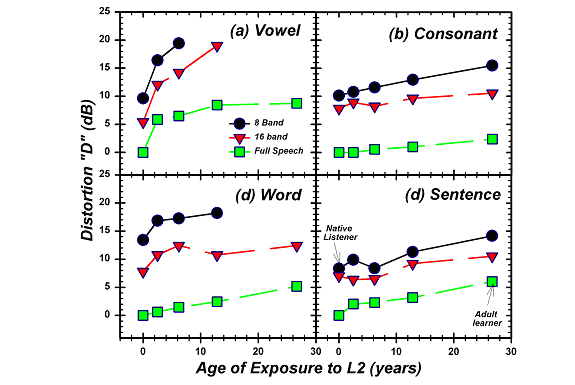Monica Padilla - mpadilla@hei.org
Robert V. Shannon
House Ear Institute
DAIP Department, 2nd Floor
2100 W. Third Street
Los Angeles, CA 90057
Popular version of paper 4pSC7
Presented Thursday afternoon, December 5, 2002
First Pan-American/Iberian Meeting on Acoustics, Cancun, Mexico
Over time, our brain develops complex pattern recognition mechanisms that are able to overcome conditions of severe distortion of the sensory information, whether it is auditory or visual. Previous studies have shown that listeners who learned a second language later in life have poorer speech recognition compared to native listeners, particularly under difficult listening conditions. These nonnative listeners require different amounts of time to develop speech pattern recognition in the English language. It is important to understand the factors that limit speech understanding by nonnative listeners under difficult listening conditions (airplane pilots, radio and telephone operators, diplomats and interpreters). We are interested in quantifying this demonstrated 'deficit' experienced by nonnative listeners as a function of the length of the exposure to the second language. To the extent that this deficit may be modeled as a hearing loss, we are also interested in relating the performance of normal-hearing listeners with the performance of cochlear implant patients. Cochlear implants are medical devices use to restore hearing to deaf patients through electrical stimulation of the auditory nerves in the cochlea. Other issues of interest to us in this study are: the effect of the conflicting vowel spaces of the two languages in vowel recognition, and the use of context by nonnative listeners compared to native English listeners.
We tested normal-hearing adult listeners (between 18 and 40 years of age) whose first language is Spanish with English consonants (a/B/a), vowels (h/ea/d), words and sentences. Different levels of noise were added to the speech signal and spectral (frequency) information was reduced to simulate the speech that a cochlear implant patient might hear. Listeners were divided into four groups according to the age at which they learned English: (A) fully bilingual, (B) extensive English exposure after the age of 5, (C) extensive English exposure between the ages of 12 and 18 and (D) extensive exposure to English after the age of 18. Most of the nonnative English listeners use English at least 50% of the time every day.
Results obtained for nonnative English listeners were compared with results previously obtained for native monolingual English listeners tested with the same stimuli. Results show that nonnative English listeners had more difficulty understanding vowels, words, and sentences, but only a slight disadvantage for consonants. Significantly lower performance on vowel recognition was seen even for fully bilingual listeners. Contrary to what was expected, adult learners (after the age of 18) had a lower performance compared to listeners who learned English between 12 and 18 years of age.
A model defined by Plomp in 1986 to find the level of the sound required to understand 50% of what is being said, was used to quantify the deficit in recognition found for nonnative English listeners. 'D' a hearing loss that cannot be compensated by hearing aids is defined in this model as distortion. Patients defined it as "I hear something, but I cannot understand what is being said". This can probably be related to nonnative listeners that "hear something, but cannot understand or cannot detect the differences between things (vowels) being said".
In some cases late learners of English did not reach 50% recognition (vowels and words) so values of 'D' could not be calculated. Figure 1 shows the results obtained for the groups tested. The curves are different for different type of stimuli tested, which shows that different processes are probably used to recognize different stimuli. The performance is very different in the case of vowels.

Figure 1. D as a function of age of learning.
Any hearing loss measured was given by distortion introduced in the speech signal by the spectral degradation, as seen in the case of native English listeners. Results suggest that 'D' increases with increased loss of spectral (frequency) resolution for all listeners, both native and nonnative. This distortion also increased as age of immersion in the second language increased (observed even in the case of bilingual listeners) as if spectral information was effectively reduced or additional distortion was introduced in the signal. These results suggest that lack of experience with the second language may be modeled as a type of hearing loss. In cochlear implant patients with English as a second language it may be possible to compensate for this hearing loss by delivering a larger number of channels of spectral information.